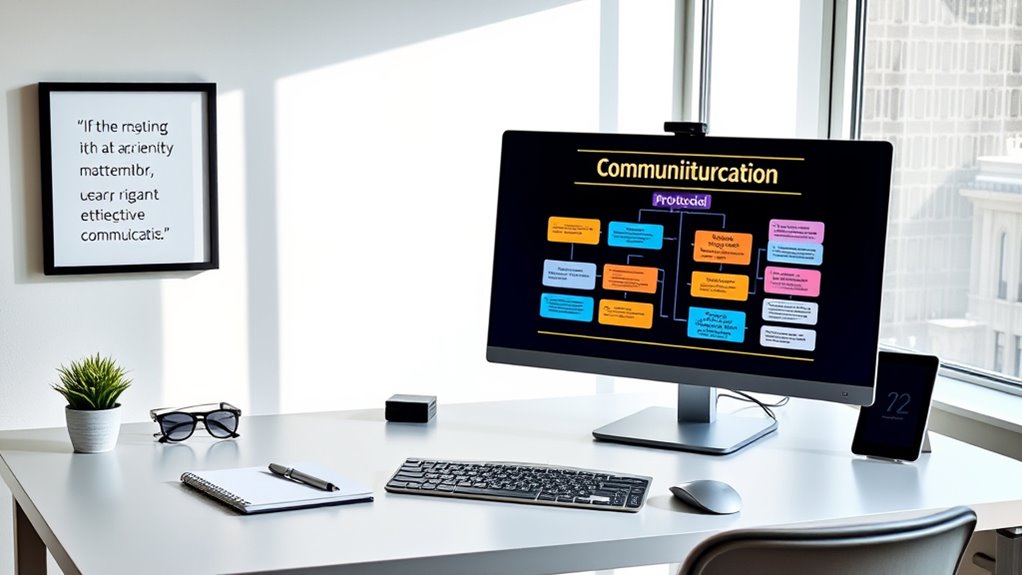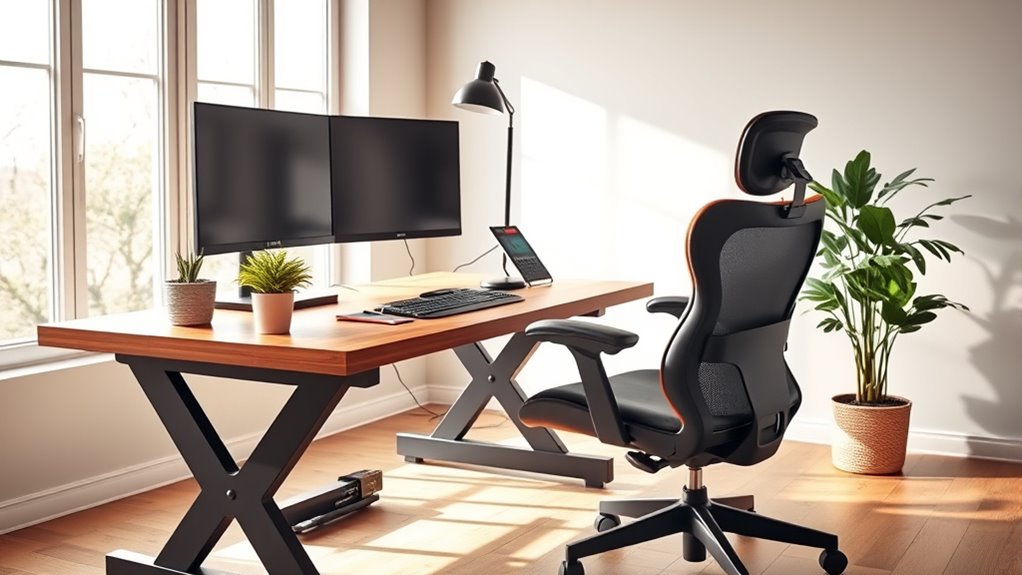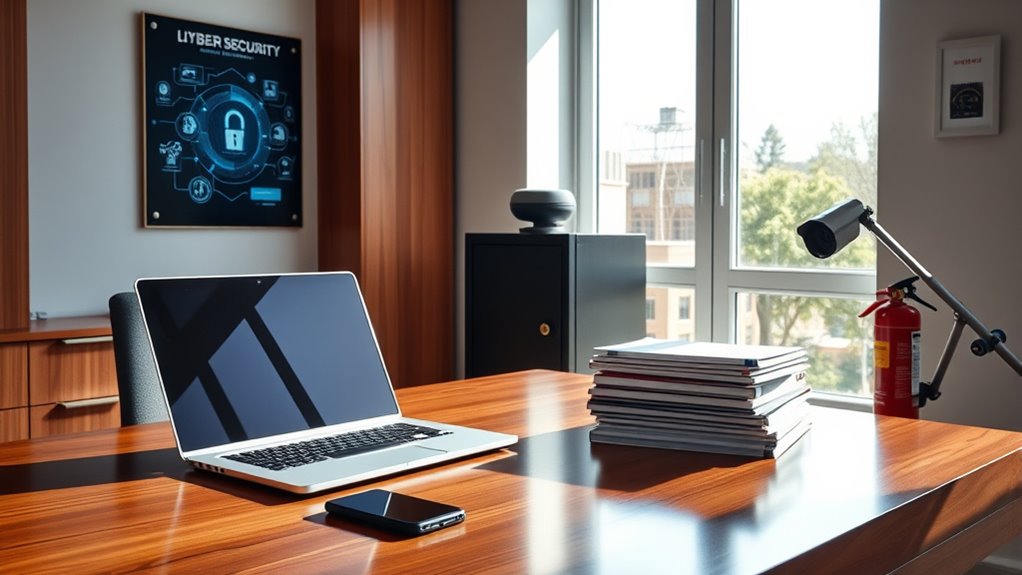To guarantee your home office stays productive during disruptions, prioritize reliable internet and backup power sources to avoid downtime. Keep your digital tools updated to prevent security risks, and don’t overlook secure storage options for your data. Establish clear communication routines and maintain ergonomic comfort to boost focus. Regularly review emergency plans and strengthen cybersecurity measures. Staying consistent with routines and safety checks keeps your workspace resilient—continue exploring to get everything aligned perfectly.
Key Takeaways
- Prioritize ergonomic setup to prevent strain and boost productivity; avoid poor posture and uncomfortable furniture.
- Ensure reliable internet and backup power sources to maintain connectivity during outages.
- Keep software and security systems up to date; avoid outdated programs and weak passwords.
- Establish clear communication routines and boundaries to prevent isolation and burnout.
- Regularly review emergency plans and safety protocols to ensure preparedness and quick response.
Prioritize Reliable Internet and Power Sources

Have you ever faced a workday disrupted by internet outages or power failures? Ensuring internet stability is essential for uninterrupted productivity. Invest in a reliable internet service provider and consider a backup connection, like a mobile hotspot, to stay connected when your primary link falters. Equally important is having a power backup, such as an uninterruptible power supply (UPS), to keep your devices running during outages. This prevents work from halting unexpectedly and protects your equipment from sudden power surges. Regularly test your backup systems to confirm they work when needed. Prioritizing reliable internet and power sources minimizes downtime, keeps you connected, and helps maintain your workflow without stress or interruptions.
Do Keep Your Digital Tools Up to Date

Keeping your digital tools up to date guarantees your work remains smooth and secure. Regularly installing software updates ensures you have the latest features and bug fixes, reducing glitches that can interrupt your productivity. These updates often include security patches that strengthen malware protection, guarding your devices against new threats. Ignoring updates can leave vulnerabilities open, risking data breaches or malware infections. Make it a habit to enable automatic updates whenever possible, so you’re always protected without manual effort. Staying current with your software also improves compatibility with other tools and platforms you use daily. Additionally, understanding the Software Development Life Cycle (SDLC) helps in managing updates more effectively, ensuring each phase of your digital environment is maintained properly. Prioritize updates for your operating system, antivirus software, and essential apps. Keeping everything current is a simple but essential step in maintaining a resilient, efficient home office setup.
Not Overlook Backup and Storage Solutions

You need reliable backup options to protect your important files in case of hardware failure or cyber threats. Cloud storage offers a secure, accessible way to keep your data safe and easily recoverable. Don’t overlook these solutions—they’re essential for maintaining your home office continuity. Incorporating a whole-house water filtration system can also ensure clean water for your home environment, supporting overall well-being during remote work.
Secure Backup Options
While selecting backup options, it’s essential to prioritize security to protect your critical data from theft, corruption, or unauthorized access. One effective strategy is using encrypted backups, which scramble your data so only you can access it. This ensures that even if your backup falls into the wrong hands, your information remains safe. Additionally, consider offsite storage solutions, keeping copies of your backups in a secure, remote location outside your home network. Offsite storage reduces the risk of losing everything if your primary system is compromised or damaged. Combining encrypted backups with offsite storage creates a robust security layer, safeguarding your data against physical theft, cyberattacks, or local disasters. Regularly monitoring your backup battery levels helps ensure your devices remain operational when needed, further supporting your home office’s continuity and data integrity.
Cloud Storage Benefits
Cloud storage offers a convenient and scalable way to access your files from any device with an internet connection. It enhances your productivity through seamless cloud collaboration, allowing you to share and edit documents in real-time with colleagues. Plus, with robust data encryption, your sensitive information stays protected from unauthorized access. Using cloud storage reduces the need for physical drives and minimizes the risk of data loss due to hardware failures or theft. It also simplifies file management, ensuring your documents are organized and easily retrievable. Whether you’re working from home or on the go, cloud storage keeps your essential files accessible, secure, and synchronized across devices. This flexibility supports your home office’s continuity and helps maintain smooth, uninterrupted workflow. Additionally, choosing a reliable cloud service can further enhance your data security and ensure consistent access.
Do Establish Clear Communication Protocols

Establishing clear communication protocols is essential to guarantee everyone stays informed and coordinated during a home office disruption. You should set expectations for how and when team members communicate, using tools like instant messaging, email, or video calls. Regular team check-ins help keep everyone aligned and provide opportunities to address concerns early. Incorporate a virtual watercooler to foster informal interactions and maintain team camaraderie, which can often suffer remotely. Clearly define who is responsible for sharing updates and how urgent messages should be handled. Encourage transparency and active listening to prevent misunderstandings. Utilizing platforms that support collaborative decision-making can further streamline communication and ensure all voices are heard. By establishing these protocols, you create a reliable communication flow that minimizes confusion and keeps your team engaged and productive, even when working remotely.
Not Ignore Ergonomic and Comfort Considerations

You need to prioritize your ergonomic desk setup to prevent strain and discomfort. Make sure your chair offers proper support to keep your back healthy throughout the day. Investing in these essentials can boost your comfort and productivity at home. Incorporating vintage industrial elements into your workspace can also inspire a unique and motivating environment.
Ergonomic Desk Setup
An ergonomic desk setup is essential for maintaining comfort and preventing strain during your workday. Proper arrangement ensures your keyboard placement allows your elbows to stay close to your sides and your wrists straight. The monitor height should be adjusted so the top of the screen is at eye level, reducing neck strain. Consider the following setup tips:
| Tip | Why it Matters |
|---|---|
| Adjust keyboard placement | Keeps wrists neutral, reduces fatigue |
| Set monitor height | Prevents neck and eye strain |
| Keep feet flat on the floor | Supports proper posture |
| Maintain arm at a 90-degree angle | Encourages natural arm positioning |
Focusing on these details can help prevent common work-related injuries and create a comfortable, efficient workspace.
Proper Chair Support
A proper chair support is vital for maintaining good posture and preventing discomfort during long work hours. When selecting an ergonomic chair, prioritize features like adjustable height, tilt, and armrests to suit your body. The ergonomic chair selection process should focus on comfort and proper alignment. Lumbar support importance cannot be overstated, as it helps maintain the natural curve of your lower back, reducing strain and preventing long-term issues. Avoid chairs without adequate lumbar support, as they can cause slouching and back pain. Invest in a chair that promotes proper spinal alignment and allows for adjustments. Remember, a well-supported seat helps you stay focused, comfortable, and productive throughout your workday. Proper chair support is a vital component of your home office setup, especially since proper disposal habits can extend the lifespan of your furniture and prevent unnecessary replacements.
Do Regularly Review and Test Emergency Plans

Regularly reviewing and testing your emergency plans guarantees they remain effective and responsive to potential threats. Schedule routine fire drills to ensure you and your household know evacuation routes and procedures. During these drills, verify that your emergency kit is complete and accessible, with essentials like water, first aid supplies, and important documents. Use these practice runs to identify gaps or weaknesses in your plan, such as unclear instructions or missing items. Update your emergency kit as needed, replacing expired supplies or adding new items. Keep everyone informed about any changes to your plan, and document test results to track improvements. Consistent review and testing build confidence and readiness, ensuring you’re prepared to act swiftly when an actual emergency occurs. Incorporating mental wellbeing strategies into your preparedness routine can also help manage stress during crises.
Not Neglect Physical and Cybersecurity Measures

While testing your emergency plans guarantees you’re ready for physical threats, safeguarding your home involves more than just drills. You must prioritize physical security by securing doors, windows, and any entry points. Install sturdy locks and consider surveillance cameras to deter intruders. Equally important is maintaining good cyber hygiene. Use strong, unique passwords for all accounts, enable two-factor authentication, and keep your software updated. Avoid clicking on suspicious links or sharing sensitive information online. Regularly review your cybersecurity practices to prevent breaches. Neglecting either aspect leaves your home vulnerable. Vetted – Halloween Product Reviews can provide additional insights into security-themed costumes and accessories that might be useful for themed safety events. Balancing physical security with solid cyber hygiene creates a holistic shield, ensuring your home office remains safe from both physical and digital threats. Stay vigilant, and don’t overlook these essential security measures.
Do Maintain a Consistent Work Routine

Maintaining a consistent work routine helps you stay focused and productive throughout the day. Set specific start and end times to create clear boundaries, even when working remotely. Incorporate virtual watercooler chats and casual check-ins to maintain team connection and morale. These informal interactions keep communication flowing and prevent feelings of isolation. Consistency in your schedule minimizes distractions and helps establish a sense of normalcy, making it easier to switch between work and personal life. Be disciplined about your breaks and avoid working outside your designated hours. By sticking to your routine, you reinforce professionalism and productivity, ensuring your home office remains an effective space for work. This approach keeps you engaged and balanced, even in a flexible environment.
Frequently Asked Questions
How Often Should I Update My Home Office Emergency Plans?
You should update your home office emergency plans at least once a year. Regularly review and practice office drills to guarantee you’re prepared, and keep your emergency contacts current. Changes in your home setup or new contact information mean your plan needs adjustments. Staying proactive helps you respond quickly during emergencies, minimizing stress and confusion. Make updates, rehearse your drills, and confirm your contacts regularly to stay fully prepared.
What Are the Best Cybersecurity Practices for Remote Work?
Don’t put all your eggs in one basket when it comes to cybersecurity. You should regularly update your password management tools and use strong, unique passwords for each account. Always connect through secure Wi-Fi and avoid public hotspots. Enable two-factor authentication whenever possible, and keep your software updated. Staying vigilant keeps your remote work safe and sound, turning a potential weak link into a fortress.
How Can I Ensure My Children’s Online Safety During Work Hours?
To guarantee your children’s online safety during work hours, set up parental controls on their devices to limit access to inappropriate content and screen time. Use online monitoring tools to keep an eye on their activity and make certain they follow safety guidelines. Communicate clear rules about internet use and stay engaged with their online activities, so you can spot any issues early and maintain a safe digital environment.
What Ergonomic Accessories Are Essential for Long-Term Comfort?
Think of your workspace as a well-tuned orchestra, where every piece plays a role in harmony. To achieve long-term comfort, invest in ergonomic chairs that support your posture and adjustable desks that let you change positions easily. These accessories prevent strain and fatigue, allowing you to focus effortlessly. Prioritize these essentials, and your body will thank you for the care, enabling sustained productivity and well-being.
How Do I Manage Distractions and Stay Productive at Home?
To manage distractions and stay productive, you should implement effective focus techniques like the Pomodoro method and set clear boundaries for your work time. Prioritize your tasks with good time management, scheduling breaks to recharge. Minimize interruptions by creating a dedicated workspace, turning off notifications, and communicating your availability. These strategies help you maintain concentration, boost efficiency, and make the most of your work-from-home environment.
Conclusion
Sticking to this checklist keeps your home office resilient, even if unexpected issues arise. You might think it’s too much to manage, but prioritizing these steps saves you time and stress later. With reliable internet, clear protocols, and cybersecurity measures in place, you’ll stay productive and secure. Remember, a well-prepared workspace isn’t just about avoiding problems—it’s about confidently handling whatever comes your way, so you can focus on what truly matters.









